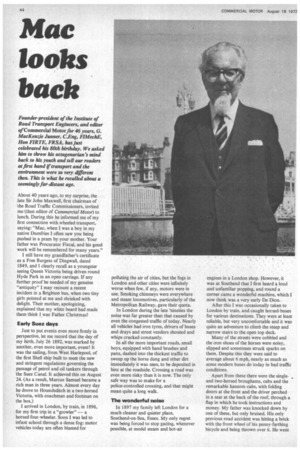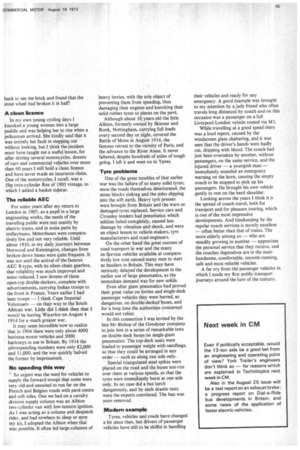Mac looks back
Page 46

Page 47

If you've noticed an error in this article please click here to report it so we can fix it.
About 40 years ago, to my surprise, the late Sir John Maxwell, first chairman of the Road Traffic Commissioners, invited me (then editor of Commercial Motor) to lunch. During this he informed me of my first connection with wheeled transport, saying: "Mac, when I was a boy in my native Dumfries I often saw you being pushed in a pram by your mother. Your father was Procurator Fiscal, and his good work will be remembered for many years."
I still have my grandfather's certificate as a Free Burgess of Dingwall, dated 1849, and I clearly recall as a youngster seeing Queen Victoria being driven round Hyde Park in an open carriage. If any further proof be needed of my genuine "antiquity" I may recount a recent incident in a Brighton bus, when two tiny girls pointed at me and shrieked with delight. Their mother, apologizing, explained that my white beard had made them think I was Father Christmas!
Early Suez days
Just to put events even more firmly in perspective, let me record that the day of my birth, July 26 1892, was marked by another, even more important, event! It was the sailing, from West Harlepool, of the first Shell ship built to meet the new and stringent regulations governing the passage of petrol and oil tankers through the Suez Canal. It achieved this on August 24. (As a result, Marcus Samuel became a rich man in three years. Almost every day he drove to Houndsditch in a two-horsed Victoria, with coachman and footman on the box.) I arrived in London, by train, in 1896, for my first trip in a "growler" — a horsed four-wheeler. Soon I was led to infant school through a dense fog: motor vehicles today are often blamed for polluting the air of cities, but the fogs in London and other cities were infinitely worse when few, if any, motors were in use. Smoking chimneys were everywhere and steam locomotives, particularly of the Metropolitan Railway, gave their quota.
In London during the late 'nineties the noise was far greater than that caused by even the congested traffic of today. Nearly all vehicles had iron tyres, drivers of buses and drays and street vendors shouted and whips cracked constantly.
In all the more important roads, small boys, equipped with hand brushes and pans, dashed into the thickest traffic to sweep up the horse dung and other dirt immediately it was seen, to be deposited in bins at the roadside. Crossing a road was even more risky than it is now. The only safe way was to make for a police-controlled crossing, and that might mean quite a long walk.
The wonderful noise In 1897 my family left London for a much cleaner and quieter place, Southend-on-Sea, Essex. My only regret was being forced to stop gazing, whenever possible, at model steam and hot-air
engines in a London shop. However, it was at Southend that I first heard a loud and unfamiliar popping, and round a corner came a wonderful machine, which I now think was a very early De Dion.
After this I was occasionally taken to London by train, and caught horsed-buses for various destinations. They were at least reliable, but very uncomfortable and it was quite an adventure to climb the steep and narrow stairs to the open top deck.
Many of the streets were cobbled and the iron shoes of the horses were noisy, slipped and sometimes struck sparks on them. Despite this they were said to average about 6 mph, nearly as much as some modern buses do today in bad traffic conditions.
Apart from these there were the singleand two-horsed broughams, cabs and the remarkable hansom cabs, with folding doors at the front and the driver perched in a seat at the back of the roof, through a flap in which he took instructions and money. My father was knocked down by one of these, but only bruised. His only previous road accident was hitting a brick with the front wheel of his penny-farthing bicycle and being thrown over it. He went back to see the brick and found that the stout wheel had broken it in half!
A clean kenos
In my own young cycling days I knocked a young woman into a large puddle and was helping her to rise when a policeman arrived. She kindly said that it was entirely her fault in Stepping out without looking, but J think the incident must have taught me a useful lesson, for after driving several motorcycles, dozens of cars and commercial vehicles over more than 60 years I still hold a Clean licence and have never made an insurance claim. One of the. motorcycles, I recall, was a 5hp twin-cylinder Rex of 1905 vintage, to which I added a basket sidecar.
The reliable AEC
For some years'after my return to London in 1907, as a pupil in a large engineering works, the needs of the travelling public were met mainly by electric trams, and in some parts by trolleybuses. Motorbuses were comparatively few and not very reliable. Until about 1910, in my daily journeys between, Norwood and Kennington, changes from broken-down buses were quite frequent. It was not until the arrival of the famous AEC B-type, with its silent-chain gearbox, that reliability was much improved and noise reduced. I saw dozens of these open-top double-deckers, complete with advertisements, carrying Indian troops to the front in France. Years earlier I had Seen troops I think Cape Imperial Volunteers -on their.way to the South African war. Little did I think then that I would be leaving Waterloo-on August 4 1914 for a much greater war.
It may seem incredible nOw to realize that in 1904 there were only about 4000 business motor vehicles and 5000 hackneys in use in Britain. By 1914 the cdrrespoading numbers were only 82,000 and 51,000, and the war quickly halved the former by impressment.
No speechng this way
' So urgent was the need for vehicles to supply the forward troops that some were 'very old and unsuited to run far on the French and Belgian roads with pave centre and soft sides. One we had on a cavalry division supply column was an Albion two-cylinder van with low-tension ignition. As I was acting as a column and despatch rider, and had nowhere to sleep or stow My kit, I adopted the Albion when that was possible. ft often led large columns of
heavy lorries, with the sole object of preventing them from speeding, thus damaging their engines and knocking their solid rubber tyres to pieces on the pave.
Although about 10. years old the little Albion, formerly owned by Skinner and Rook. Nottingham, carrying full loads every second day or night, covered the Battle of Mons in August 1914, the famous retreat to the vicinity of Paris, and the advance to the River Aisne. It never faltered, despite hundreds of miles of tough going. I left it and went on to Ypres.
Tyre problenis
One of the great troubles of that earlier war was the failure of so many solid tyres; soon the roads themselves deteriorated, the stone blocks sinking and the sides slipping into the soft earth. Heavy tyre presses were brought from Britain and the warn or damaged tyres replaced. Service ears and Crossley tenders had pneumatics which seldinn failed completely, caused less damage by vibration and shock, and were an object lesson to vehicle makers, tyre manufacturers and road engineers.
On the other hand the great success of road transport in war and the many ex-§ervice vehicles ayailable at comparatively low cost caused many men to start as hauliers in Britain. This may have seriously delayed the development in the earlier use of large pneumatics, as the immediate demand was for new solids.
Even after giant pneumatics had proved their great value on lOrries and single-deck passenger vehicles they were barred, as -dangerous, ondouble-deekedhuses, and for a long time the authorities concerned would not relent.
• -In this connection I was invited by the late Mr Bishop of the Goodyear company to join him in a series of remarkable tests on-doable-deck buses on single-giant pneumatics.' The top-deck seats were loaded to passenger weight with sandbags, so that they could be arranged in any order — such as along one side only.
Special triangulated steel spikes were placed on the road and the buses test-run over them at various speeds, so that the tyres were immediately burst at one side only. In no case did a bus lurch dangerously, and by snch drastic tests were the experts convinced. The ban was soon removed.
Modem example
Tyres, vehicles and roads have changed a lot since then, but drivers of passenger vehicles have still to be skilful in handling
their vehicles and ready for any emergency. A good example was brought to my attention by ailady friend who often travels long distances by coach and on this Occasion was a passenger on a full Liverpool-London vehicle routed via Ml.
While travelling at a good speed there was a loud report, caused by the windscreen glass shattering, and it was seen that the driver's hands were badly cut, dripping with blood. The coach had just been overtaken by another, without passengers, on the same service, and the injured driver — a youngish man — immediately sounded an emergency warning on the horn, causing the empty coach to be stopped to pick up his passengers. He brought his own vehicle gently to rest on the hard shoulder.
Looking across the years I think it is the spread of coach travel, both for transport and for pleasure touring, which is one of the most impressive
developments. And timekeeping by the regular coach services is mostly excellent — often better than that of trains. The more-elderly among us — who are steadily growing in number -appreciate the personal service that they receive, and the coaches themselves are in the main handsome, comfortable, smooth-running, safe and most reliable vehicles.
A far cry from the passenger vehicles in which I made my first public transport journeys around the turn of the century.


































































































